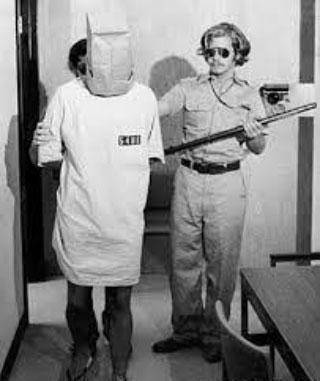27 Mar 2021 - {{hitsCtrl.values.hits}}
 The Stanford Prison Experiment, carried out my Zimbardo and colleagues in 1971 remains one of the best-known studies in the field of Psychology. The study was born out of Zimbardo’s desire to investigate the violent and unsympathetic nature that was often attributed to American prison guards. He questioned whether the guards possessed these traits inherently, or whether the traits were learnt as a result of the harsh environment in which they spent much of their time.
The Stanford Prison Experiment, carried out my Zimbardo and colleagues in 1971 remains one of the best-known studies in the field of Psychology. The study was born out of Zimbardo’s desire to investigate the violent and unsympathetic nature that was often attributed to American prison guards. He questioned whether the guards possessed these traits inherently, or whether the traits were learnt as a result of the harsh environment in which they spent much of their time.
In order to test his theories, Zimbardo converted a basement at Stanford university into a prison scene, consisting of bare walls, boarded doors and windows, and small cells. He then advertised his study in the papers, asking for volunteers to partake in it. He received responses from twenty-five participants, who went through a testing process to ensure that they were fit to take part in the study. At the end of this process, twenty-four men were chosen to partake, and were paid $15 daily for their participation.

A Prisoner and a Guard
|
Of the twenty-four chosen, only twenty-one ended up partaking in the actual study. Eleven participants were assigned to the role of prison guard, and ten were assigned to the role of prisoner. The participants assigned to the role of prisoner were arrested without warning, their biometric data was recorded, and they were made to take mugshots.
Upon arrival at the prison scene, the prisoners were stripped of their personal possessions, made to change into prison uniform, and given bedding and a number by which they would be referred to for the rest of the study. The guards were also given a uniform. They were given the freedom to do whatever they thought necessary in order to maintain order in the prison scene, as long as it did not involve physical violence.
Interestingly, the guards began to abuse their power almost immediately, waking the prisoners up at 2:30am on the first night by incessantly blowing their whistles. They also bullied the prisoners, made them carry out many pointless tasks, and subjected them to gruelling physical punishments, such as making them do countless push ups. The prisoners too, adapted to their roles relatively quickly. They would rat each other out to the guards, complain about prison related issues, and take the prison rules extremely seriously.
On the second day of the experiment, the prisoner’s rioted by removing their numbers, and pushing their beds against their cell doors. In response, the guards used a fire extinguisher to force the prisoners to back away from the doors. They then broke into the cells, stripped the prisoners, and removed the beds from the cells. The organisers of the riot were placed in solitary confinement. The prisoners least involved in the riots were given special privileges, including being given their beds back and being allowed to wash their hair.

Philip Zimbardo
|
In the wake of the riot, the relationship between the prisoners and the guards became even more strained. The guards treated the prisoners as if they were worthless, and the prisoners became subdued in response. Around thirty-six hours into the experiment, one of the prisoners began to experience disorganised thinking, uncontrollable anger and crying, and clear emotional disturbance. At this point, the psychologists had to make a call to remove him from the experiment.
On the third day of the experiment, a visiting hour was held for parents and friends of the prisoners. The guards instructed the prisoners to clean their cells prior to the arrival of the guests, and put on a show of camaraderie between the prisoners and the guards. After the visiting hour was over, rumour spread of a mass escape plan which led to the increased ill treatment of the prisoners by the guards, in an attempt to regain their authority.
Although intended to be two weeks long, the Stanford Prison Experiment was terminated at the six-day mark due to multiple prisoners having emotional breakdowns, and the aggressive nature of the guards. Although considered both, unethical and deeply flawed in today’s literature, Zimbardo and colleagues believed that the findings of these studies could be used to explain how willing people are to conform to the societal roles that they are expected to fulfil. As the behaviour of both the guards and the prisoners was heavily affected by the environment they were in, the findings of this study can be used to support the situational explanation of behaviour, and not the dispositional one.
09 Jan 2025 9 minute ago
09 Jan 2025 41 minute ago
09 Jan 2025 46 minute ago
09 Jan 2025 1 hours ago
09 Jan 2025 1 hours ago